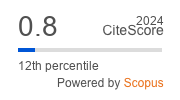DLTS SPECTRA OF SILICON DIODES WITH P+—N–JUNCTION IRRADIATED WITH HIGH ENERGY KRYPTON IONS
https://doi.org/10.17073/1609-3577-2014-1-42-46
Abstract
p+-n-Diodes have been studied. The diodes were manufactured on wafers (thickness 460 μm, (111) plane) of uniformly phosphorus doped float–zone–grown single–crystal silicon. The resistivity of silicon was 90 Ohm · cm and the phosphorus concentration was 5 · 1013 cm–3. The diodes were irradiated with 250 MeV krypton ions. The irradiation fluence was 108 cm–2. Deep–level transient spectroscopy (DLTS) was used to examine the defects induced by high energy krypton ion implantation. The DLTS spectra were recorded at a frequency of 1 MHz in the 78—290 K temperature range. The capacity–voltage characteristics have been measured at a reverse bias voltage from 0 to –19 V at a frequency of 1 MHz. We show that the main irradiation–induced defects are A–centers and divacancies. The behavior of DLTS spectra in the 150—260 K temperature range depends essentially on the emission voltage Ue. The variation of Ue allows us to separate the contributions of different defects into the DLTS spectrum in the 150—260 K temperature range. We show that, in addition to A–centers and divacancies, irradiation produces multivacancy complexes with the energy level Et = Ec – (0.5 ± 0.02) eV and an electron capture cross section of ~4 · 10–13 cm2.
Keywords
About the Authors
N. A. PoklonskiBelarus
Doctor of Physics and Mathematics, Professor
N. I. Gorbachuk
Belarus
Candidate of Physics and Mathematics, Associate Professor
S. V. Shpakovski
Belarus
Candidate of Physics and Mathematics, Leading Design Engineer
Viktor Anatol’evich Philipenya
Belarus
Leading Engineer;
A. S. Turtsevich
Belarus
Doctor of Technical Sciences
S. V. Shvedov
Russian Federation
Deputy Chief Engineer
Quang Nha Vo
Belarus
PhD Student;
Thi Thanh Binh Nguyen
Belarus
Master Student
V. A. Skuratov
Russian Federation
Doctor of Physics and Mathematics
D. Wieck Andreas
Germany
Prof. Dr.
References
1. Poklonski N. A., Gorbachuk N. I., Shpakovski S. V., Filipenia V. A., Skuratov V. A., Wieck A. Kinetics of reverse resistance recovery of silicon diodes: The role of the distance the metallurgical p+n-junction — defect layer formed by 250 MeV krypton implantation. Physica B. 2009, vol. 404, no. 23−24, pp. 4667—4670. DOI: 10.1016/j. physb.2009.08.129
2. Poklonski N. A., Gorbachuk N. I., Shpakovski S. V., Petrov A. V., Lastovskii S. B., Fink D., Wieck A. Electrical properties of silicon diodes with p+n junctions irradiated with 197Au+26 swift heavy ions. Nucl. Instrum. Meth. B. 2008, vol. 266, no. 23, pp. 5007—5012. DOI: 10.1016/j.nimb.2008.09.001
3. Sathyavathi P., Bhave P. S., Bhoraskar V. N. Irradiation effects of 35 MeV lithium and 70 MeV oxygen ions on the hole lifetime and the forward current of silicon diodes. Solid State Commun. 1998, vol. 106, no. 11, pp. 755—758. DOI: 10.1016/S0038-1098(98)00116-1
4. Bhave P. S., Bhoraskar V. N. Irradiation effects of high energy heavy ions on the switching characteristics of p-n junction diodes. Nucl. Instrum. Meth. B. 1997, vol. 127/128, pp. 383—387. DOI: 10.1016/S0168−583X(96)00962-7
5. Nastasi, M., Mayer J. W. Ion implantation and synthesis of materials. Berlin: Springer, 2006. 263 p.
6. Chelyadinskii A. R., Komarov F. F. Defect−impurity engineering in implanted silicon. Phys. Usp. 2003, vol. 46, no. 8, pp. 789—820. DOI: 10.1070/PU2003v046n08ABEH001371
7. Ito A., Tokuda Y. Deformation of a deep−level transient spectroscopy spectrum by an inhomogeneous carrier concentration depth profile. Solid−State Electron. 2002, vol. 46, no. 9, pp. 1307—1313. DOI: 10.1016/S0038−1101(02)00077-1
8. Ito A., Tokuda Y. Effects of inhomogeneous carrier concentration depth profile on deep−level transient spectroscopy measurements. J. Cryst. Growth. 2000, vol. 210, no. 1−3, pp. 384—387. DOI: 10.1016/S0022−0248(99)00716-2
9. Novikov V. A., Peshev V. V. Effect of nonuniform distribution of radiation defects in GaAs on the DLTS spectra. Semiconductors. 1998, vol. 32, no. 4. pp. 366—371. DOI: 10.1134/1.1187397
10. ULSI technology / Ed. by C. Y. Chang, S. M. Sze. N. Y.: McGraw−Hill, 1996. 726 p.
11. Ziegler J. F. SRIM−2003. Nucl. Instrum. Meth. B. 2004, vol. 219-220, pp. 1027—1036. DOI: 10.1016/j.nimb.2004.01.208
12. Sze S. M. Semiconductor devices: Physics and technology. N. Y.: Wiley, 2001. 568 p.
13. Eremin V., Verbitskaya E., Li Z. Effect of radiation induced deep level traps on Si detector performance. Nucl. Instrum. Meth. A. 2002, vol. 476, no. 3, pp. 537—549. DOI: 10.1016/S0168-9002(01)01640-0
14. Moll M., Fretwurst E., Kuhnke M., Lindstroem G. Relation between microscopic defects and macroscopic changes in silicon detector properties after hadron irradiation. Nucl. Instrum. Meth. B. 2002, vol. 186, no. 1−4, pp. 100—110. DOI: 10.1016/S0168-583X(01)00866-7
15. Hazdra P., Komarnitskyy V. Lifetime control in silicon power p−i−n diode by ion irradiation: Suppression of undesired leakage. Microelectron. J. 2006, vol. 37, no. 3, pp. 197—203. DOI: 10.1016/j.mejo.2005.09.010
16. Eremin V. K., Ivanov A. M., Strokan A. M. False peaks in DLTS spectra of planar diode structures. Sov. Phys. Semiconductors. 1992, vol. 26, no. 3, pp. 269—271.
17. Antonova I. V., Shaĭmeev S. S., Smagulova S. A. Transformation of electrically active defects as a result of annealing of silicon implanted with high-energy ion. Semiconductors. 2006, vol. 40, no. 5, pp. 543—548. DOI: 10.1134/S106378260605006X
18. Markevich V. P., Peaker A. R., Hamilton B., Lastovskii S. B., Murin L. I., Coutinho J., Torres V. J. B., Dobaczewski L., Svensson B. G. Structure and electronic properties of trivacancy and trivacancy−oxygen complex in silicon. Phys. Status Solidi A. 2011, vol. 208, no. 3. pp. 568—571. DOI: 10.1002/pssa.201000265
Review
For citations:
Poklonski N.A., Gorbachuk N.I., Shpakovski S.V., Philipenya V.A., Turtsevich A.S., Shvedov S.V., Vo Q., Nguyen T., Skuratov V.A., Andreas D. DLTS SPECTRA OF SILICON DIODES WITH P+—N–JUNCTION IRRADIATED WITH HIGH ENERGY KRYPTON IONS. Izvestiya Vysshikh Uchebnykh Zavedenii. Materialy Elektronnoi Tekhniki = Materials of Electronics Engineering. 2014;(1):42-46. (In Russ.) https://doi.org/10.17073/1609-3577-2014-1-42-46





































